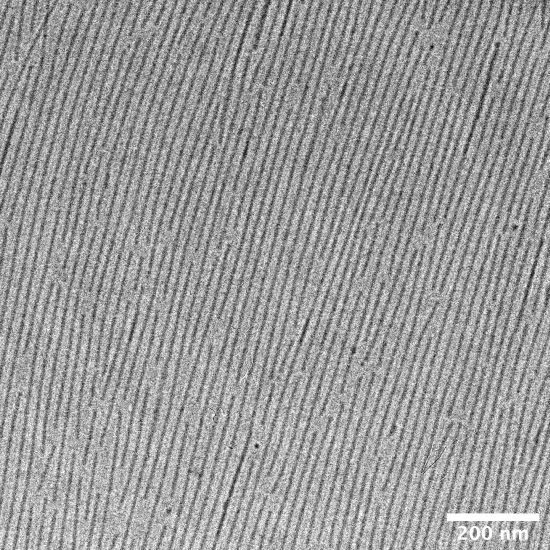COULD THIS NEW HYDROGEL MAKE HIV THERAPY MORE CONVENIENT?
A new injectable solution that self-assembles into a gel under the right conditions could help manage HIV unlike any currently available methods, Johns Hopkins researchers have foundBy Roberto Molar Candanosa

Transmission electron microscopy image of supramolecular hydrogelator filaments bearing lamivudine.
CREDIT: HAN WANG/JOHNS HOPKINS UNIVERSITY
September 25, 2023 — A new injectable solution that self-assembles into a gel under the right conditions could help manage HIV unlike any currently available methods, researchers have found.
The gel releases a steady dose of the anti-HIV drug lamivudine over six weeks, suggesting people living with HIV could have new therapy that doesn't require a daily pill regimen to prevent AIDS.
"The primary challenge in HIV treatment is the need for lifelong management of the virus, and one way to address this is to reduce dosing frequencies to help patients stick to medical regimens," said Honggang Cui, a Johns Hopkins University chemical and biomolecular engineer who led the research. "This new molecular design shows us a future in which drug hydrogelation can do that to improve HIV treatment."
The research is published in the Journal of the American Chemical Society.
"OUR GOAL IS TO HELP IMPROVE PEOPLE'S QUALITY OF LIFE. THE ANTIVIRAL SUBSTANCE CAN BE INJECTED UNDER THE SKIN AND REMAIN IN PLACE OVER AN EXTENDED PERIOD, RELEASING THE THERAPEUTIC COMPOUND SLOWLY AND CONSISTENTLY—A CRITICAL NEED FOR INDIVIDUALS WITH HIV."
—Honggang Cui
Professor, Whiting School of Engineering
Cui's team demonstrated that in test tubes simulating the conditions of plasma, the liquid portion of blood, the gel quickly separates into molecules of lamivudine. By injecting the gel in the backs of mice, the researchers found one injection was sufficient to maintain effective and lasting drug concentrations for 42 days with nearly no side effects.
"Our goal is to help improve people's quality of life," Cui said. "The antiviral substance can be injected under the skin and remain in place over an extended period, releasing the therapeutic compound slowly and consistently—a critical need for individuals with HIV."
For people living with HIV, the key is maintaining bloodstream drug levels at concentrations that suppress virus load in the body. But that can be difficult with traditional approaches because the body naturally rids itself of these chemicals, Cui said, which is why different treatments require different dosages and dosing frequencies to work.
The researchers plan to continue testing their work with medications used in combination therapies along with lamivudine, as most of these treatments involve a cocktail of two or more drugs. Because lamivudine is an FDA-approved drug to treat HIV and hepatitis B, the researchers said the hydrogel could also help manage hepatitis B.
"This is a novel way to deliver anti-HIV meds, and this platform has the advantage that a single polymer can be programmed to deliver several different drugs simultaneously," said co-author Charles W. Flexner, a professor of medicine, pharmacology, and molecular sciences in the Johns Hopkins School of Medicine. "One of the drawbacks of the approved injectable HIV treatments is that none have activity against hepatitis B virus, which is a common co-infection with HIV, especially in Asia and Africa. This formulation delivers lamivudine, a drug active against both HIV and HBV, but can also be modified to deliver tenofovir, which is the current standard of care for HBV treatment."
In the long term, the team envisions their hydrogel working as a preventive measure, similar to how some people take anti-HIV drugs to avoid infection.
"Keeping the high drug levels in plasma for 42 days is very impressive," Cui said. "But in the future, we hope it will be even longer."
Hydrogels have unique water-absorbing properties that give them a jellylike consistency resembling biological tissue. The new gel undergoes self-formulation, stays close to the site of injection, and separates into molecules that can fend off the virus without the need for additional carriers or delivery materials.
"The most exciting aspect of these gel filaments is that they consist entirely of the therapeutic agent itself," Cui said. "Everything originates from the same compound after injection, and this simplest drug formulation could streamline the regulatory approval process once clinical efficacy is demonstrated."
The team tweaked the molecular properties of lamivudine to act as the building blocks of a supramolecular polymer, a large chain of repeating molecules that can either stick together tightly or come apart, depending on temperature, pH, and other external conditions.
Authors include Han Wang, Maya Monroe, Feihu Wang, Mingjiao Sun, and Charles Flexner, all from Johns Hopkins.
The research was supported by the Johns Hopkins University Center for AIDS Research under NIH/NIAID P30AI094189.
Contacts:
Roberto Molar Candanosa
Science Communications Manager
University Communications
Johns Hopkins University
rmolarc1@jh.edu
C: 443-938-1944 O: 443-997-0258
Source: JHU Hub - Johns Hopkins University
https://hub.jhu.edu/2023/09/25/hydrogel-hiv-therapy/
"Reproduced with permission - Johns Hopkins Medicine"
www.hopkinsmedicine.org
For more HIV and AIDS News visit...
Positively Positive - Living with HIV/AIDS:
HIV/AIDS News |